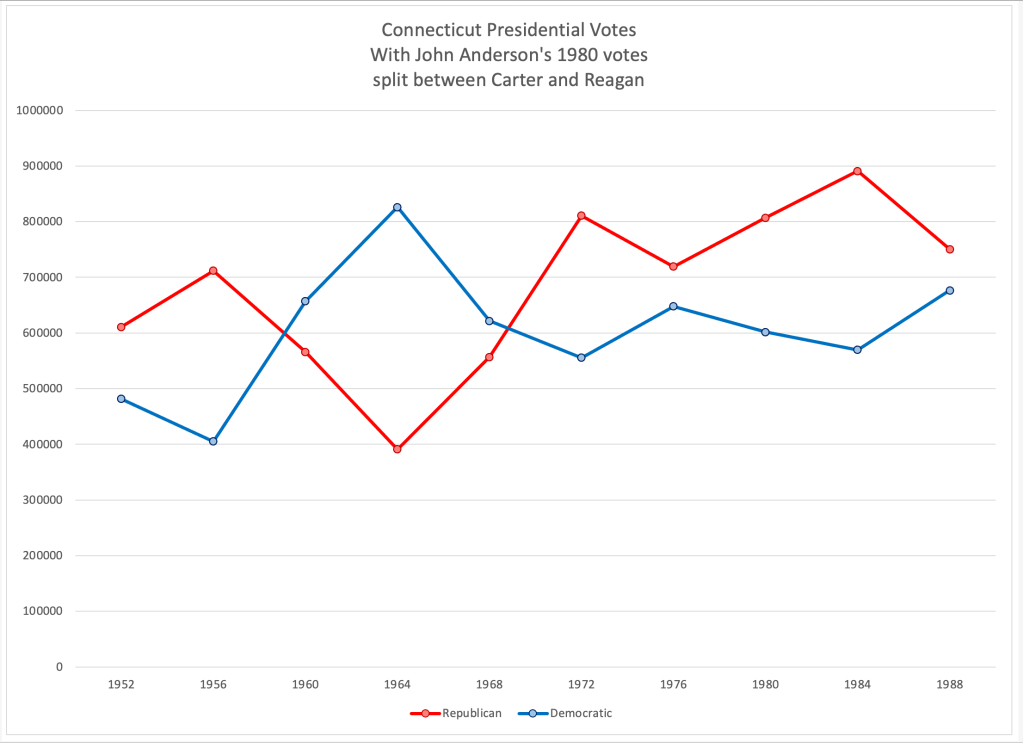Why do I look at total votes in UFT elections?
It seems obvious that we should be focused on percents. What did Unity win by? 66% to 34%. What happened in high schools? United for Change won with 56%. Unity’s 67% was a record low for them in Elementary Schools. Yet in my analysis, I have focused on total votes, not percents. Why?
See analysis at:
If Unity and the opposition were competing for the same votes, then when Unity’s votes went up, non-Unity votes would go down, and vice versa. I claim that we are fishing for votes mostly in separate ponds – and that an opposition increase and a Unity increase can happen at the same time.
Connecticut
Just take a look at this pretty chart:

Those are Connecticut votes for president 1952 – 1988.
See the longterm upward trend? It’s there. Imagine halfway between the red and the blue. It starts around 550,000, and climbs pretty steadily to about 700,000.
Also see how the red and blue dance? When red rises, blue falls. When blue rises, red falls.
Do you see the one year that doesn’t fit? 1980. John Anderson siphoned off a bunch of votes. Raise the red dot to 810,000 and the blue to 600,000 – and there’s our pattern, clear as day:
That chart is not real, but only 1980 has been altered. And there it is, gentle up slope, and red goes up when blue goes down and blue goes down when red goes up. The electorate is growing, slowly, and the Democrats and Republicans are competing for the same votes.
Notice, by the way, that Connecticut used to vote pretty differently from how it votes today.
United Federation of Teachers
Do the numbers dance? Do Unity numbers rise when non-Unity numbers fall, and vice versa, or do they move independently?

Where to begin?
The blue line drops sharply in 2007, 2013, and 2022, but only in 2022 is there a corresponding rise in the green line. The lines rise together in 2016, fall together in 2019.
Unity and non-Unity draw votes from separate pools. This is not the Connecticut map – the lines are moving independently. They are expanding and shrinking their own bases. They are not drawing votes from each other.

The blue and the green move in the same direction in five of the six year after year comparisons. However, in two of those Unity has a sharp fall while the non-Unity votes hold steady. There is no indication that the two sides are trading votes. They are fishing in separate ponds.

First of all, these lines almost always move in the same direction.
Second, look at the last three cycles. The opposition loses a ton of votes in 2019. Where do they go? Not to Unity. The opposition gains back a ton in 2022. Where did they get them from? Not Unity. During the same time period Unity’s votes stayed the same.

See how the lines rise together in 2016? They are not poaching each other’s votes. The only year they seem to dance, this year, the Unity fall was far greater than the non-Unity rise. This does not break the pattern.
Conclusion
Unity and the non-Unity groups are, for the most part, not directly competing for votes.
Opposition votes may or may not be cast. The struggle is getting people to vote.
Unity votes may or may not be cast. They are nearing a crisis because they cannot get their own people to vote. But their coming crisis is not being caused by the non-Unity groups; it is their failure to energize their own folks.
Analysis of 2022
Limiting the discussion to in-service, we now ask two questions: How did Unity do? How did United for Change do? We will answer each, without referring to the other.
How did Unity do?
Unity continued to lose voters across every in-service division. They may be leveling out in high schools. We would need more evidence to support that. But it is possible that they have hit rock bottom in this division.
How did United for Change do?
United for Change recovered from the separate caucus’ very weak showing in 2019 – but not to the level of 2016. It is not a bad election, but nor is it a major breakthrough.
Next up: analysis of retiree voting.


Trackbacks